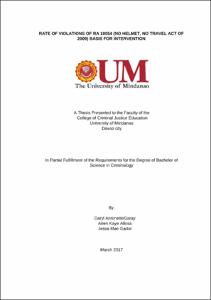Rate of violations of RA 10054 (no helmet, no travel act of 2009) : basis for intervention

View/
Date
2015Author
Garay, Daryl Antonette
Allosa, Airen Kaye
Gador, Jessa Mae
Citation Tool
Metadata
Show full item recordAbstract
Motorcycle laws are enacted for the purpose of protecting the motorists. This study was conducted to determine the rate of violations and the intervention needed involving No Helmet, No Travel Act of 2002 (R.A. No. 10054) in Davao City, Philippines. A letter was forwarded to the Land transportation Office requesting for the data of the rate of violators for the month of January-September 2016 of the said Republic Act. There were no respondents in this study. Instead, the statistician tallied the data that was acquired by the researchers from the LTO. Results show that in terms of No Helmet, March has the highest rate of violations of No Helmet, No travel Act of 2002 (R.A. 10054). In terms of excess passenger, February has the highest rate of violations of No Helmet, No Travel Act of 2009 (R.A 10054). While in terms of wearing of flip flops, August has the highest rate of violations of No Helmet, No Travel Act of 2009 (R.A 10054) Hence, the researchers conducted an intervention to create and propose an alternative plans for the provisions of No Helmet, No Travel Act of 2009 (R.A 10054) to lessen and maintain the certainty of enforcing the said law for the benefits of the motorists in Davao city and for the better and safe living of the residents of Davao City.
Key words: intervention, alternative plans, safe living, enforcing the law, violations, LTO, motorist
Collections
- Undergraduate Theses [639]
Publisher
College of Criminal Justice Education
